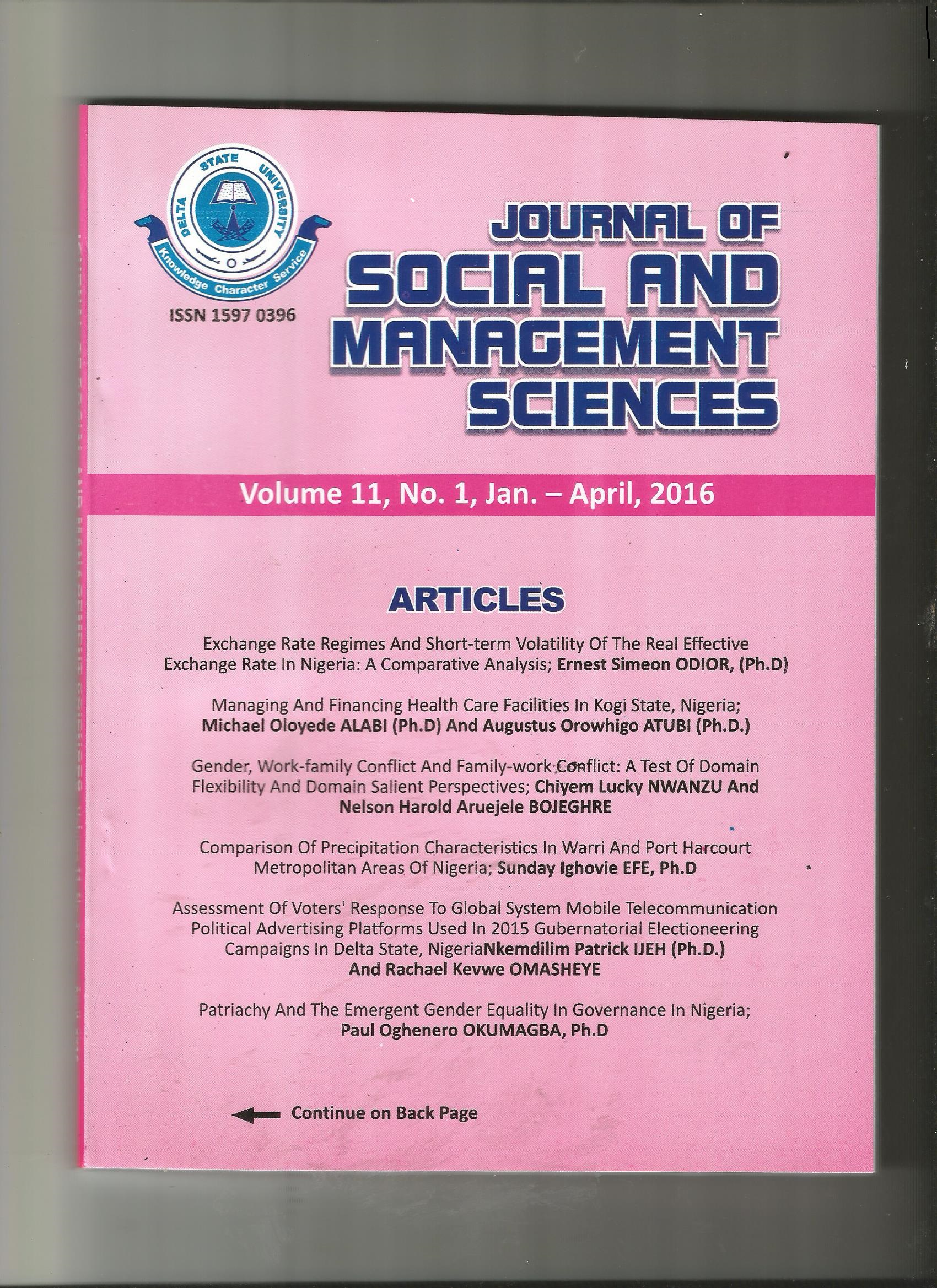
JOURNAL OF SOCIAL AND MANAGEMENT SCIENCES
Journal of the Faculty of Social Sciences, Delta State University, Abraka, Nigeria
ISSN: 1597-0396
DOI: 10.5987/UJ-JSMS
Email: jsms@universityjournals.org
GENDER AND AWARENESS PATTERN OF HIV/AIDS IN DELTA STATE, A GEOGRAPHICAL PERSPECTIVE
DOI: 10.5987/UJ-JSMS.17.060.1 | Article Number: 5C12909B7 | Vol.12 (1) - April 2017
Author: SAJINI Iwejingi Faith
Keywords: Nigeria, Gender, Awareness HIV/AIDS
In Nigeria to which Delta State is a part, lack of awareness of HIV/AIDS has been projected as a major factor influencing the spread and pattern of HIV/AIDS prevalence. This research examined the gender and awareness pattern of HIV/AIDS in Delta State from a geographical perspective. The specific objectives are to; identify the level of awareness of HIV/AIDS by gender in Delta State, generate spatial map of the gender and awareness pattern of HIV/AIDS using GIS tool in the form of Arc view 9 and make recommendations. Data were sourced from both primary and secondary sources. Stratified sampling method was used to stratify Delta State into three senatorial zones following the existing strata i.e Delta North, Delta South and Delta Central senatorial districts. Within each Stratum, simple random sampling was employed to select the local government areas from where data were obtained. A total of nine (9) local government areas were selected from the three senatorial districts. 2350 copies of questionnaire were administered and 2169 copies were successfully retrieved. An independent sample ttest statistical technique was used to test the hypothesis of the study. The findings are; that awareness of HIV/AIDS is high in Delta state and that gender is not a factor of awareness variation in Delta state. By these findings, the research has contributed to existing knowledge by proving that ignorance is no longer a factor of HIV/AIDS spread, therefore, researches will now be redirected to other factors perpetuating the spread of HIV/AIDS in Delta state other than ignorance. Behavioural change campaign is recommended in Delta state in addition to the ongoing awareness campaign.
Anarfi, J.K. (1993). Women's Migration, Livelihoods and HIV/AIDS in West Africa .In UNESCO (2004) Women Migration and HIV/AIDS; An Anthropological Approach. Studies and Reports, special series, issue 22 Paris.
Asthana, D. k and Asthana, M. (2006). A textbook of Environmental Studies. Delhi : S. Chand & company. Pp 357
Awofala A.A and Ogundele E.E. (2016). HIV Epidemiology in Nigeria, Saudi Journal of B i o l o g i c a l S c i e n c e s . http://dx.doi.org/10.1016/j.sjbs.2016.03.0 06
Center for Diseases Control and prevention (CDC) ( 2 0 1 5 ) H I V a n d W o m e n https://www.cdc.gov/
Dickson, D.B (2010). Diffusion of Innovation. The Principal of Limited Possibilities, the Hagarstrand Model, Diffusion and Indigenism. http/www.jrank.org/
Falobi, O. (1999) in Oppong J.R. (2003). Medical Geography of Sub-Saharan Africa. In Aryeetey – Attoh (ed). Geography of Sub- Saharan Africa. Upper Saddle River, USA : Pearson Education Inc.
Federal Government of Nigeria (2003). National Policy on HIV/AIDS.NACA
Federal Ministry Health (2013) National HIV/AIDS and Reproductive Health Survey-Plus (2012), Nigeria
Guinness, p. and Nagle,G. (2006). Advance Geography, Concept and Cases. Hodder Murray. History and Science of HIV/AIDS http://www.avent.org/history.science.htm
Higgins, J.A. ,Hoffma, S and Dwokin S.L (2010). Rethinking Gender, Heterosexual men and Women Vulnerability. Am J. Public Health 100(3)
Molebatsi, C and Mogobe, K.D (1999). Ngamiland and Comprehensive plan on HIV/AIDS : phase 1 Situation and Response analysis. In Mainstreaming Gender into HIV/AIDS Initiatives National Workshop 17-19 June 2002, Gaboron
NACA (2007). Update on National Response to the HIV/AIDS epidemic Pp 9
National Bureau of Statistics (2014) Statistical Report on Women and Men in Nigeria
Oppong J.R. (2003). Medical Geography of Sub- Saharan Africa. In Aryeetey – Attoh (ed). Geography of Sub-Saharan Africa., Upper Saddle River, USA: Pearson Education Inc.
Shaibu, S and Dube, M (2002). Key Gender Issues in HIV/AIDS Preventions and Care: Toward a Gender- Sensitive Multi- Sectoral approach. Mainstreaming Gender into HIV/AIDS Initiatives National Workshop 17-19 June 2002, Gaboron
UNDP (2012). Mainstreaming Gender into National HIV Strategy and Plans. A Road M a p . U N D P – H I V, H e a l t h & Development. Bureau Development Policy. New York.
UNESCO (2004). Women Migration and H I V / A I D S ; A n A n t h r o p o l o g i c a l Approach. Studies and Reports Special Series, Issue D22, Division of Culture, Policies and Inter-cultural dialogue Paris.
